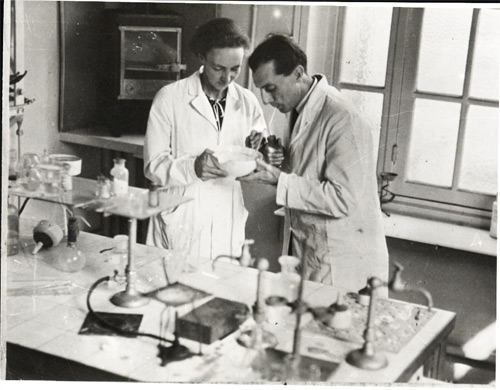Unstable nuclei which emit radiations
The vast majority of atomic nuclei found in Nature are stable; which means that they do not decay over time. The reason is that almost all unstable nuclei, by definition, have decayed and vanished over time.

1934 and the discovery of artificial radioisotopes
Most of radioactive nuclei have vanished from earth, but some have been recreated by man. In the beginning of 1934, Irène and Frédéric Joliot-Curie produced in their laboratory a radioactive atom of phosphorus which didn’t exist in nature by bombarding a sheet of aluminium by alpha particles. This phosphorus atom disintegrated like a natural radioactive element. Because of its numerous applications, particularly medical, the discovery of artificial radioactivity had an enormous impact. Its importance was quickly recognized. In 1935, Irène and Frédéric Joliot-Curie were awarded the Nobel Prize.
© ACJC (AssociationCurie/Joliot-Curie)
As a result, there are only two types of unstable nuclei that are commonly found in the natural environment; those with a lifetime extending to billions of years (such as uranium or thorium), and those that are constantly regenerated. Included among the latter are nuclei whose existence is perpetuated thanks to the presence of cosmic radiation, and all nuclei formed from the radioactive decay of uranium or thorium.
Since the discovery of artificially-created radioactivity in 1934, very many of these extinct nuclei have been recreated in laboratory conditions. Most, however, decay within a small fraction of a second.
The determining factor of a nucleus stability is the competition between attractive and repulsive forces among its constituents. Any nucleus is formed from a combination of neutrons and protons (known collectively as nucleons), with the naturally-occurring varieties ranging from one solitary proton (hydrogen) to a combined total of 238 nucleons (uranium). With so many particles in such a small volume, the description of the forces within the nucleus rapidly becomes exceedingly complicated. As a result, physicists often use simplified models, which provide similar results. One particularly popular one is the comparison of the nucleus to an incompressible droplet of water.
At first glance, the nuclear stability appears impossible; a nucleus contains only particles of positive charge (protons) and those with no charge at all (neutrons) would not interact. As like charges repel, any nucleus should fall apart very quickly. In fact, the reason for a nucleus stability is a strong attractive force acting over small distances in the nuclei, which overcomes the electrostatic repulsion. The existence of such forces was only postulated in the 1930’s.
A third force is also present in the nucleus, which adjusts the neutron : proton ratio so as to maximise the energy binding them together. Under the influence of these three forces, nuclei produced in the Big Bang at the hearts of stars have gradually evolved towards stability. On a graph representing the relationship between the number of protons and the number of neutrons, all naturally-occurring elements are to be found on a straight line – known as the line of stability – ranging from hydrogen to uranium.
Learn more :
Articles on the subject « Radioactive nuclei »
Map of Nuclei
Map of stable and unstable nuclei The progress made in our understanding of the subatomic world o[...]
Stability Valley
Beta decay : nuclei getting slimmer to achieve stability The nucleus mass is related to its inter[...]
Nuclear Forces
Three nuclear forces and their hierarchy Three types of force act alongside each other inside a n[...]
Mecanisms of Radioactivity
The way radioactivity works and its origins The impressive range of half-lives that exist, extend[...]
α decay : tunnel effect
Particle and wave: an effect of quantum mechanics The great age of uranium and thorium nuclei tha[...]
Alphas with gammas
Gamma rarely accompanies alpha decays It is surprising that one can hold with hands a sample of p[...]
β decay : weak forces
The forces which allow a nucleus to emit beta electrons Beta decay (β) and electronic capture cha[...]
Weak Forces
A special and fascinating fundamental interaction A third force is at work in the nucleus next to[...]
The Nucleosynthesis
Primordial and stellar nucleosynthesis The Universe hasn’t always existed, It was born a li[...]
Nucleosynthesis (continued)
Mechanisms of atomic nuclei formation Most of the nuclei of atoms that make up our daily life wer[...]